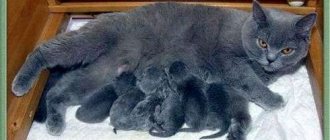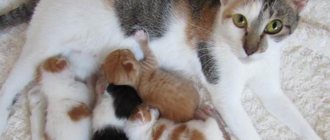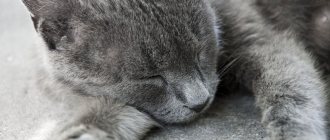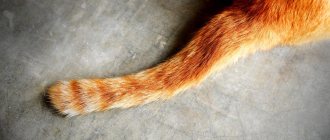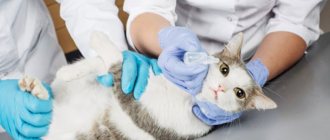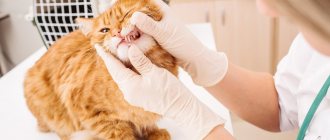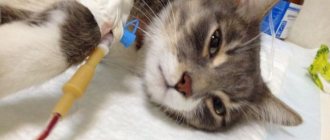Causes of the disease
A fracture is a violation of the anatomical integrity of the bone and adjacent tissues. It can be acquired or congenital and occur under the influence of external force or pathology, respectively.
If we talk about congenital pathologies of the bone structure, they are diagnosed in only 1-2% of the total number of visits to veterinary clinics with fractures. The reasons for the birth of kittens with limb fractures are intense labor, osteoporosis, rickets, osteomalacia in the expectant mother.
Veterinarians distinguish two types of acquired bone injuries based on the cause of their occurrence: pathological and traumatic. The first group includes fractures that occurred as a result of osteosarcoma, osteomalacia, etc.
Traumatic fractures occur not only due to various injuries received as a result of falling from a height, being run over by a car, or fighting with an opponent, but also due to unprofessional obstetric care.
Unlike a fracture, a dislocation is a violation of the anatomical location and a change in the physiological functions of the joint. The bone remains intact. Dislocations are also divided into two categories: acquired and congenital. The causes of dislocations are similar to those of fractures.
Not a single animal is insured against acquired dislocations and fractures. Breeds such as Persians, Maine Coons, and Himalayan cats are predisposed to congenital joint pathologies.
Main symptoms
In case of fractures and dislocations, the animal exhibits general clinical signs: pain, impaired motor function (lameness), swelling of the damaged area.
There are three types of fractures: closed, open, and displaced. Serious damage also includes cracks.
Signs of an open fracture in a cat:
- violation of the integrity of the skin;
- the bone is broken, its ends are displaced and protrude;
- tissue rupture in the fracture area;
- bleeding;
- strong pain.
With open wounds, the risks of tissue necrosis and infection are very high.
A closed fracture without displacement is characterized by the following symptoms: the broken bone is in its usual position, the skin and tissues swell, turn blue, and turn red. In a displaced fracture, the bone diverges in different directions, and the soft tissue is partially damaged. There is a danger of internal bleeding.
A crack can easily be confused with a bruise. The bone remains intact, its edges do not diverge and are held in place by the intact area. The cat may move carefully, but it may be in pain.
A simple dislocation is recognized by the following signs:
- skin and tissue remain intact;
- lameness;
- inability to lean on the surface;
- pain when touching the injured limb;
- The dislocated part of the body is asymmetrical.
A complex dislocation, accompanied by rupture of ligaments and tendons, is characterized by the appearance of hematomas in the injured area.
Features of different types of fractures in cats
When a cat or kitten has a broken leg, we are talking about damage to the tubular bone components. Such fractures are considered classic in veterinary practice. Much less frequently diagnosed are injuries to the femur, lower leg (tibia and fibula), shoulder and forearm (radius and ulna).
Atypical cases of bone injuries that occur as a result of loss of vigilance or in an extreme situation are quite rare in domestic cats. The most complex and dangerous of these injuries are fractures of the spine and pelvic bones.
Table 2. Features of rare types of bone fractures in cats
| Fracture location | Causes | Signs | Treatment |
| Fingers | Fractures of the small bones of the wrist, foot, metacarpus, and digital phalanges most often occur when an animal falls out of a window or a paw is pinched. Sometimes such damage occurs due to being hit by a car. | You can tell that a cat has broken toes by severe lameness or the inability to step on the injured limb. The animal experiences pain, but there is often no swelling of the skin. Such fractures are usually closed. | The need for surgery is determined by the doctor. X-rays are required. Most often, the pain area is fixed with a tight bandage, and the animal’s motor activity is limited for 1–2 months. |
| Spine | Serious injuries, fractures of high complexity. Appear due to: falls from great heights, car injuries, bites, bruises. | When injuries occur in the thoracolumbar region, paralysis of the cat's hind limbs occurs; the animal does not control bowel movements and urination. Cervical injuries cause paralysis of all limbs. A fracture in the sacral area allows the cat to move, but creates problems with bowel movements. | The main problem with such fractures is the threat of damage to the spinal cord. It is necessary to urgently take the animal to the clinic. Treatment for such injuries is exclusively surgical. Osteosynthesis is performed using knitting needles and screws. Postoperative observation in the clinic lasts up to 7 days. Motor functions are restored after a month, provided the integrity of the spinal cord is intact. |
| Ribs | Car injuries, falling out of a window, fights with dogs. | The animal breathes with its mouth open, there are open wounds in the chest area, and an asymmetrical arrangement of the ribs. Shortness of breath may occur. Often, rib fragments provoke the development of pneumothorax - an accumulation of air inside the chest. | Such fractures often lead to lung injuries and internal bleeding. With closed injuries, it is difficult to assess the severity of the situation. It is necessary to urgently take the cat to the doctor. At the clinic, the wounds are numbed and x-rays are taken. For single fractures, a bandage is applied. Serious injuries are treated surgically with drainage and rib reconstruction. |
| Pelvic bones | Automobile injuries, falls from great heights. | The presence of blood in the excrement, the appearance of problems with support on the hind limbs. | Such fractures are dangerous for the integrity of the bladder, uterus, and intestines. Injuries to these organs are eliminated by a doctor first. The pelvic bones are fused using osteosynthesis, using plates and metal rods. Rehabilitation lasts from 14 to 70 days. |
| Tail | Tail pinching, bites. | Tail immobility, curvature, pain. With an open fracture, there are visually noticeable wounds. | In most cases, the doctor prescribes classical therapy. External fixation of the tail is performed for up to 30 days. If functional disorders appear below the injured area, the tail is amputated above the fracture. |
| Jaw | Fall from a window, injury. Risk factors are: advanced age of the animal, gingivitis or periodontitis. | The cat cannot eat or close or open its mouth. The appearance of blood from the mouth, asymmetry of the muzzle. | Immediate treatment is required. Such fractures (usually open) provide an opportunity for microbes to penetrate the jaw tissue. Treatment is carried out through osteosynthesis using wire sutures, knitting needles, and plates. A day after the operation, the animal is already able to eat liquid food. |
Interesting! Approximately half of pelvic fractures in cats can be treated without surgery. Animals are placed in a cage for 2 months, given regular anesthetic injections, and provided with hygienic care. This therapy is prescribed if the cat’s hip joints are not damaged and there are no severe bone displacements.
Responsibility for the life and health of pets lies with their owners. To avoid fractures of paws or other parts of the body in cats, you need to try to eliminate at least the main causes of injuries from their lives.
But if trouble does happen, you cannot set broken bones yourself; the animal needs to be given first aid and taken to a veterinary clinic as quickly as possible.
In most cases, the quality of the cat’s treatment and its future fate depend on the speed of contacting a doctor. It is important to remember that the animal will instinctively take care of the paw that has healed after surgery for several more months. The owners’ task in this case is to monitor the cat’s motor activity and not let it become too overloaded.
Diagnostics in a veterinary clinic
The fact that the pet has been injured is immediately obvious, but a visit to the veterinary clinic is necessary. After examining your pet and conducting a series of diagnostic tests, the veterinarian will determine the extent of the damage and prescribe appropriate treatment.
Necessary diagnostic methods include general and biochemical blood tests, x-rays in two projections, and cardiac echocardiography. In some cases, an abdominal ultrasound is required.
Home care
If you have witnessed your cat being hit by a car or falling from a great height and you suspect a fracture, you should put a splint on the injured paw. This procedure will immobilize the broken limb. A flat board can be used as a tire, or, in the absence of one, thick cardboard folded several times.
The splint must be applied in such a way as to be able to fix two joints close to the fracture, below and above. The structure should be wrapped with a bandage in several layers. After this, you need to take the victim to a veterinary clinic.
For open fractures, the wound is closed with sterile gauze, and a splint is applied on top.
If you are sure that your cat has a dislocation, then under no circumstances try to straighten the injured limb yourself! With your inexperienced actions and ignorance of cat anatomy, you can cause irreparable harm to your pet. Apply an ice pack to the affected limb, apply a tight bandage, and take your pet to a veterinarian.
To alleviate the cat’s condition and relieve it from traumatic shock, many owners inject the animal with an anesthetic. However, veterinarians do not recommend doing this at home. Without feeling pain, a cat can cause even more harm to itself.
In addition, analgesics distort the symptoms of injury. Finally, sedation will be required during the X-ray examination, and pre-administration of pain medication will negatively affect the health of the pet.
The animal should be transported to the veterinary clinic lying down in the back seat of the car. The pet should be placed on a horizontal surface - plywood, board, car panel - and secured in the area of the shoulder blades and pelvis with a rope or belt.
The owner’s task is to provide the pet with the most comfortable living conditions during treatment of fractures. A cat's mobility can have a negative impact on its well-being, so freedom of movement should be limited. The ideal option would be to place the animal in a cage for 2-3 weeks.
This design should be quite free, but at the same time not allowing the pet to move a lot. You need to put a tray and bowls of food and water in the cage.
How to bandage a cat's paw, bandaging technique
We learn how to properly bandage a cat's paw.
How to bandage a paw - Most often, as a result of an accident, cats are bandaged on their paws, and in order not to constantly consult a doctor and not disturb the animal (it is a well-known fact that cats do not like visiting a veterinary clinic), it is advisable to learn how to change the bandages yourself. The bandage on the paws most often gets dirty and wet. By the way, this is the easiest bandage to remove from a cat’s paw.
The bandaging technique described below can be used for any injury.
If you have an assistant, then let him hold the cat, but if there is no assistant, then you can handle this procedure yourself. But you will have to do the whole operation with one hand, and hold the cat with the other; you can lightly squeeze the cat between your knees, but do not overdo it.
♦ Prepare a bowl of warm water, hold the cat, place the paw in the bowl and lightly rinse the injured paw. You can also use an antiseptic solution. If blood starts to flow from the wound, immediately remove the paw and bandage it to stop the bleeding.
♦ Gently dry the paw, trying to dry it as much as possible. Then apply a tampon soaked in a special composition (ointment) to the wound (bleeding or weeping). The veterinarian will tell you the composition or ointment based on your wound. The tampon should not stick to the wound.
♦ Place small pieces of cotton wool on the cat's toes and then wrap the cotton wool around the cat's paw. The cotton bandage should reach approximately the middle of the cat's paw and be about two centimeters thick. This layer can protect the paw from being squeezed when you bandage it.
♦ Apply a bandage using a bandage. First wrap the bandage around each finger and then around the cat's wrist. Don't forget to leave a cotton collar over the bandage.
You can use an adhesive plaster instead of a bandage. Although the patch is more convenient for bandaging, especially if you change the bandage yourself, you should not forget that the patch can stick to the cat’s fur, which means additional pain when removing the bandage.
How to treat fractures and dislocations
Simple fractures are treated with conservative methods. These include pain relief and elimination of pain shock. Immobilization using splints and splints is used to restore damaged bone. For pain relief, drugs such as Traumeel and Butomidor are used. Splints and braces are removed only after the veterinarian gives permission to do so.
For complex types of fractures, surgery cannot be avoided. Osteosynthesis involves removing small bone fragments and realigning large ones. Surgical intervention using fixing metal structures should be carried out immediately after diagnosing a fracture.
Pins, plates and spokes made from a special alloy with titanium remain in the animal’s body for life.
After surgery, as well as in cases of open fractures, antibiotic therapy is indicated.
The regeneration process will be helped to speed up by drugs that improve osteosynthesis, vitamin therapy, and physiotherapy.
If a cat has been diagnosed with a dislocation, treatment includes pain relief and realignment of the injured limb, followed by the application of a fixing bandage. In severe cases, surgery is indicated.
As for the prognosis for fractures and dislocations, in most cases it is favorable. The only exceptions are spinal fractures with damage to the spinal cord structure. If the fracture causes rupture of large vessels of the limb or peripheral nerves, then for the cat this ends in the loss of the limb.
Dislocations should not be underestimated: if the damage is not treated, it can subsequently lead to complex muscle deformations and destruction of articular surfaces. As a result, the cat will limp for the rest of its life.
Cat Vasya with a bandaged paw and a solid income
Share
- tweet
When I had an office in Dzerzhinets, I walked past the supermarket every day on my way to work and back. Well, you know, like a shopping center, on the first floor there is a grocery store, on the second there are all sorts of pavilions. And under the stairs to the second floor there was a tiny kiosk selling animal food. Absolutely unremarkable, except for one thing. There, near the window, stood a shoebox, on which was written by hand - “For lunch to Vasily.” Or “Get food for you”, in different ways. Because the boxes deteriorated and changed, the inscription also changed. Only the owner of the box himself did not change. Who was sitting right there, below.
It was such a big black gloomy cat. He sat under his box all day. But he didn’t just sit, no. Vasya had a bandaged front right paw, from the claws up to the elbow, and when someone walked past on the second floor, he stretched out this paw in front of him, tilted his head to the side, and looked pitifully into the eyes of the passerby. His appearance changed dramatically! Like an experienced repeat offender on trial. From a gloomy bastard, he instantly turned into such a pathetic little pussy. Need I say that in such situations, Vasya’s daily revenue significantly exceeded the turnover of the kiosk itself? I once looked into the box out of curiosity. You know, there were no small things there. Vasya was served generously.
At first, watching Vasya, I decided that this was the kiosk seller’s cat. It turned out not. The kiosk was closing, the seller went his way, and Vasya went hers. Most likely it was just a stray cat. All his free time from work, while the shopping center was closed, he wandered around the neighborhood. However, every day, at exactly half past eight in the morning, he sat at the door of the store and waited for the opening. And the bandage on his paw shone white. I watched this beast almost every day for two years. Of course, his paw was absolutely healthy, and in his free time from compassionate glances, he used it like all his other relatives. Except for one thing. Wherever Vasya was, no matter what he was doing, whether he was poking around in the trash heap, or tore up a gaping musky, but as soon as he noticed a human gaze on himself, he immediately dropped everything, sat down, stretched out his bandaged paw in front of him, looked the passerby in the eyes, and his appearance became pitiful and cute. But! If you walked by once and didn't put anything in the box, you became an empty space for him. When he saw you, he no longer pulled his paw and did not look pitiful. He simply didn't notice you. He remembered everyone. I have never met another living being in my life who could so clearly demonstrate that you do not exist. It's an unpleasant feeling, you know. When you seem to exist, but you are not.
Here you go. And then the premises on the second floor were bought by a bank, and trade was removed from there. The pet food kiosk has moved two blocks to the center. And Vasya disappeared. It didn't disappear right away, no. For some time, every day, from half past eight, he steadily took his place at the door. And waited for the opening. But the door did not open. Vasya, of course, was fed by the grocery store clerks. But he categorically did not want to go there. He didn’t want to move to a new place either. The saleswoman from the kiosk complained: “I took it away three times! And I put the box! Doesn't sit, it's an infection! At least tie it!” Of course she was sad. Such a chunk of the day's earnings went past the cash register. And then Vasya completely disappeared, and I forgot about him. Until, probably a year later, I accidentally stopped at a gas station on Staraya Yaroslavka. At an empty gas station, right under the cash register window, a large black sullen cat was sitting. With a bandaged paw. Right front.
- Wow! - I said joyfully. - So here you are, rascal! Did you get a job?
Vasya demonstrated the complete absence of me in the space surrounding him.
- Aaaah! Remember me, you son of a bitch! — I laughed at Vasya’s vindictiveness, but was not at all upset.
Having received change at the cash register, he separated a fifty-ruble bill, thrust it under Vasya’s nose, and said: “Here!” Look! — he pointedly placed a plastic box with a solid inscription “FOR CAT” in the cash register window standing next to it. Vasya didn’t even bat an eye.
- Well, okay! - I said, turned around, and went my way.
- Mrrryyyyy! - suddenly came from behind.
I turned around in surprise. Vasya sat, stretching out his bandaged paw to me, and he looked so pitiful and unhappy that you could almost cry.
PS After I published this story in Zhezhe, I received the following comment: “Hello! I accidentally read your story and decided to write about Vasya. You know, I worked as a cashier at the gas station you write about. Right now I’m actually on maternity leave. Vasya died about a year ago, we were all so worried. We got used to him, he lived at our gas station, everyone loved him, both employees and drivers who constantly refuel at our place. And from the money he “earned,” we didn’t take a penny for ourselves, no matter what anyone thought. We used it to buy cat food and give it to a woman who feeds stray cats and dogs nearby. We did not give her money, but bought food ourselves. And “he earned a lot. So Vasya fed not only himself, but also many of his brothers. May he rest in peace. Thank you for your story."
So it goes.
Author
Rehabilitation period
How long the recovery phase will last depends on the severity of the fracture, the general condition and age of the cat. In young individuals, it usually lasts three weeks, with a maximum of 30 days. In an old cat, the healing process is longer - 35-40 days.
To monitor proper fusion of the bone structure, your pet should be taken to a veterinary surgeon for a monthly check-up.
In order to restore the motor function of the damaged limb, elasticity and muscle tone, manual massage should be performed, the technique of which will be introduced by the veterinarian. Daily massage procedures stimulate blood circulation, healing of periosseous tissues, and accelerate the process of bone fusion.
A cat's diet should be balanced, nutritious and easily digestible. The animal needs foods enriched with phosphorus and calcium. However, we must remember that an excess of these components often leads to the formation of stones in the gall bladder and kidneys.
Vitamin and mineral supplements will also help speed up your pet's recovery, but they can only be given after consultation with a specialist. The veterinarian prescribes vitamins based on the animal’s needs.


